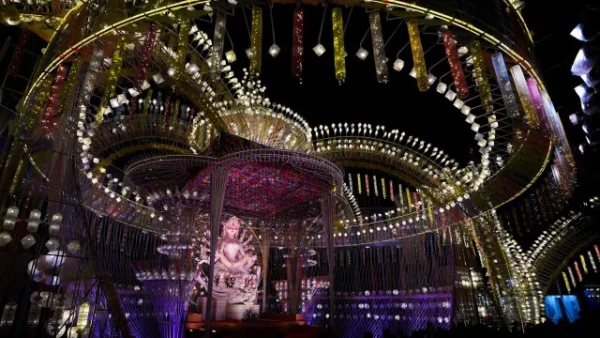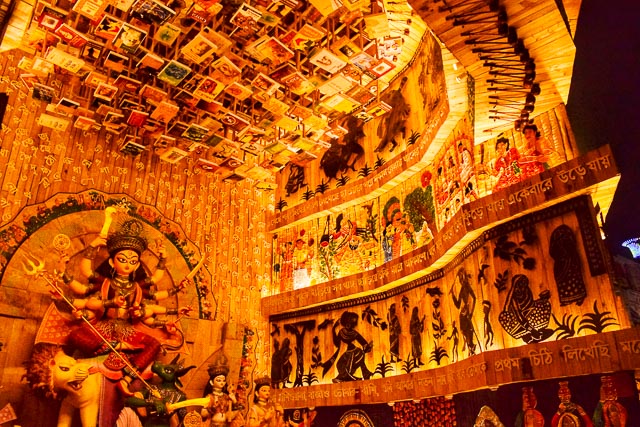Durga Puja in West Bengal is a festival of devotion, culture, and art. Explore its pandals, decorations, artisans, budgets, prizes.

Durga Puja Celebration in West Bengal, India
Durga Puja is more than a festival in West Bengal.
It is a season of joy, colours, devotion, and community spirit.
For Bengalis, it’s not just about rituals. It’s about celebrating love, art, and togetherness.
The streets come alive with lights and music. Families unite. Strangers smile at each other. There is a special warmth in the air that can be felt only during this time.
The Significance of Durga Puja
Durga Puja honours Goddess Durga’s victory over the demon Mahishasura.
It celebrates the power of good defeating evil.
The festival usually falls in September or October and lasts for several days.
People prepare for weeks in advance. Artisans build grand idols of Goddess Durga with her ten arms, riding a lion. Each idol carries powerful symbolism. Her strength represents protection, courage, and justice.
Just like Ganesh Chaturthi celebrates wisdom and strength, Durga Puja celebrates divine power and feminine energy. You can explore more about Ganesha’s stories here: Ganesh Chaturthi – Stories of Love, Wisdom, Strength, and Devotion.
The Spectacular Pandals
One of the most exciting aspects of Durga Puja is the pandal.
A pandal is a temporary structure built to house the Goddess. But it is also a canvas for art, imagination, and devotion.
Decoration and Themes
Pandals are designed with creative themes.
Some replicate ancient temples, while others depict modern art, social messages, or even global landmarks.
The interiors are lavishly decorated with lights, flowers, fabrics, and handmade props.
Every element tells a story — from Durga’s fierce battles to symbols of peace and prosperity.
The Artisans Behind the Magic
The making of pandals involves hundreds of skilled artisans, carpenters, painters, electricians, and decorators.
Bamboo frameworks form the skeleton. Clay and plaster bring life to the sculptures. Fabrics, paints, lights, and mirrors add glamour.
Artisans often work day and night for months to complete a single pandal. Their work is physically demanding and requires immense creativity.
Many of these artisans belong to families that have been creating pandals for generations, passing on traditional techniques and craftsmanship.
Budget and Funding
Creating a large, iconic pandal is costly.
Small community pandals may cost ₹3–5 lakh, while elaborate Kolkata pandals can cost ₹50–70 lakh or more.
The expenses cover materials, idol making, lighting, sound systems, decorations, and cultural programs.
Funds come from community donations, local clubs, sponsors, and sometimes even corporate partnerships.
Volunteers often contribute their labour to reduce costs, and communities take pride in supporting the festival financially and physically.
Prizes and Recognition
Many pandals participate in competitions organized by local authorities or cultural committees.
The awards recognise creativity, theme execution, craftsmanship, and innovation.
Winners often receive cash prizes, trophies, or certificates. But for most communities, the pride of creating a memorable experience for devotees is reward enough.
These competitions inspire even more elaborate and innovative designs each year, turning Durga Puja into a yearly display of artistic excellence.
Days of Celebration and Rituals
The main days of the festival are Shashthi, Saptami, Ashtami, Navami, and Dashami.
Each day has its own unique rituals.
- Shashthi welcomes the Goddess.
- Saptami marks the beginning of major rituals.
- Ashtami is the most powerful day, with special prayers and the iconic Pushpanjali (flower offerings).
- Navami is filled with devotion and cultural programs.
- Dashami is emotional, as people bid farewell to the Goddess with Sindoor Khela (vermilion play) and immersion ceremonies.
Women dress in traditional red and white sarees. Men wear kurtas. People visit pandals together, share food, and click countless pictures.
The immersion of the idol in rivers marks the end of the festival. But for Bengalis, it’s a promise — “Ma will return next year.”
Culture, Food, and Togetherness
Durga Puja is not just a religious event; it’s a cultural celebration.
Throughout West Bengal, especially in Kolkata, cultural performances like dance, drama, and music take place every evening.
Food plays a big role too. Streets are filled with stalls offering phuchka, kathi rolls, mughlai parathas, sandesh, and other delicious Bengali sweets.
Families cook festive meals at home and invite friends over.
The sense of community is beautiful. People of all religions and backgrounds join the celebrations. It is a festival that brings everyone together.
For similar emotional bonds during festivals, you can read about Raksha Bandhan – A Sacred Bond of Love and Protection.
Global Recognition
Durga Puja is no longer confined to West Bengal. It has gained international recognition.
In 2021, UNESCO included Kolkata’s Durga Puja in its list of Intangible Cultural Heritage of Humanity.
This acknowledgment brought immense pride to the Bengali community around the world.
For more global cultural insights and celebrations, you can explore www.america112.com.
Final Thoughts
Durga Puja is an experience that words can barely capture.
It is about faith, art, music, food, and emotions woven together.
Pandals showcase human creativity and devotion in grand ways.
The hours of hard work, the artistry, the community funding, and the pride in creation all come together to make Durga Puja a festival of excellence and joy.
When the dhak (traditional drum) beats echo through the streets, hearts beat along with it.
It reminds everyone that good always triumphs over evil.
And that communities, when united in joy and devotion, can create magic.

